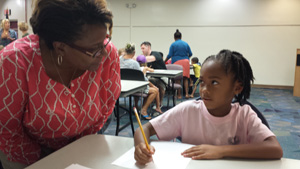 We know “writing anchors reading.” So how can we let the entire summer pass without supporting student writing? That was nagging primary-grade teachers at Hollin Meadows Science and Math Focus School in Alexandria, VA. The answer: Develop an innovative weekly literacy outreach program for summer vacation called “Writing Nights” to imitate the writers’ workshop students experience daily during the school year.
We know “writing anchors reading.” So how can we let the entire summer pass without supporting student writing? That was nagging primary-grade teachers at Hollin Meadows Science and Math Focus School in Alexandria, VA. The answer: Develop an innovative weekly literacy outreach program for summer vacation called “Writing Nights” to imitate the writers’ workshop students experience daily during the school year.
Coordinated by reading teacher Sally Chadbourn and first-grade teacher Kathy Boykin for a teachers-as-researchers project, kindergarten and grade 1 and 2 colleagues collected data from “writing on demand” samples during the school year, which gave students time to write independently during writers’ workshop. Data showed writing development correlated with reading progress.
As a result of that research, each week during the summer of 2014, staff held Writing Nights to provide equivalent time to students for writing and reading. Sessions were held for students ages 5–8 at Sherwood Regional Library in Alexandria, VA, Mondays 6:30 p.m.–7:30 p.m.
Fifteen teachers, preK–grade 3, volunteered in rotating teams of five members to provide writers’ workshops to children who had never experienced classroom instruction and their parents. For this Title I elementary school of 600 students, school principal Jon Gates (another Monday night stalwart) encouraged staff to use the school’s e-mail list and robo-call system each weekend reminding families in English and Spanish to attend Writing Nights.
“We had no idea what attendance would be last summer, yet felt we had a ‘hit’ on our hands and were meeting children’s needs when the library meeting room routinely topped maximum capacity,” recalls Ann Avila, Writing Nights’ coordinator and a first-grade teacher. “We averaged 45 students plus 45 parents every Writing Night. One of the librarians expressed concern that we might even be breaking fire code regulations with so many busy people in the meeting room!”
Each Monday night, two teachers launched a carefully designed focus lesson with a read-aloud to introduce writers’ crafts to the diverse young audience: informational text about local critters, squirrels, rabbits, and raccoons; poetry with onomatopoeia; alphabet books; maps; how-to procedures for gardening. With one teacher soliciting students’ ideas and another teacher recording their thinking through shared or interactive writing, children co-constructed a mentor text to serve as an example of the featured genre and writer’s craft. During independent writing, parents imitated teacher teams and conferred with their own young author-illustrators. Finally, everyone gathered in sharing circles as children reluctantly quit drawing and writing to become peer-partners and display their work to friends and families.
“Yes, the goal for both Writing Nights and the summer book mailing program was to make sure children’s writing and reading didn’t suffer what’s known as ‘summer slide,’” stated Avila. “But we’ve also achieved another goal: developing a sense of community centered on the public library. It provides a wonderful atmosphere for families to come together on Writing Nights, talk and get to know each other, and learn.” Parents of kindergarten students praised the program for introducing them to school curriculum, instruction, and a network of friends before the school year began through the program.
The result was W Is for Writing Nights,similar to alphabet books read aloud as mentor texts. During Writing Nights, rising K–3 students wrote and illustrated their own record of the program. Students took home copies of the pages they wrote as mementos of their participation. In addition, these same students and all other rising Grade K–3 pupils receive books mailed to them four times during the summer as part of Hollin Meadows’ decade-old summer book mailing program to help families establish home libraries.
Writing Nights are now a summer tradition. The 8-week program will start June 29 with—by popular demand—an added 15 minutes each week!

 Sally Chadbourn is a reading teacher and Ann Avila teaches grades 1–3 at Hollin Meadows Science and Math Focus School in Alexandria, VA.
Sally Chadbourn is a reading teacher and Ann Avila teaches grades 1–3 at Hollin Meadows Science and Math Focus School in Alexandria, VA.